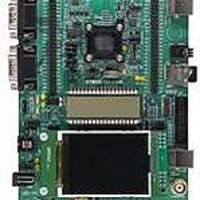STM32L152-EVAL STMicroelectronics, STM32L152-EVAL Datasheet - Page 16

STM32L152-EVAL
Manufacturer Part Number
STM32L152-EVAL
Description
BOARD EVALUATION FOR STM32L
Manufacturer
STMicroelectronics
Type
MCUr
Specifications of STM32L152-EVAL
New! Us2012 Catalog Page
STM8L-Discovery_STM32L152-EVAL
Contents
Board
Processor To Be Evaluated
STM32L1xxx
Interface Type
UART
Operating Supply Voltage
2 V to 3.6 V
For Use With/related Products
STM32L
Lead Free Status / RoHS Status
Lead free / RoHS Compliant
Other names
497-10842
Functional overview
3.4
16/107
The boot loader is located in System Memory. It is used to reprogram the Flash memory by
using USART1 or USART2. For further details please refer to AN2606.
Clock management
The clock controller distributes the clocks coming from different oscillators to the core and
the peripherals. It also manages clock gating for low power modes and ensures clock
robustness. It features:
●
●
●
●
●
●
●
●
●
●
Several prescalers allow the configuration of the AHB frequency, the high-speed APB
(APB2) and the low-speed APB (APB1) domains. The maximum frequency of the AHB and
the APB domains is 32 MHz. See
Clock prescaler: to get the best tradeoff between speed and current consumption, the
clock frequency to the CPU and peripherals can be adjusted by a programmable
prescaler
Safe clock switching: clock sources can be changed safely on the fly in run mode
through a configuration register.
Clock management: to reduce power consumption, the clock controller can stop the
clock to the core, individual peripherals or memory.
Master clock source: three different clock sources can be used to drive the master
clock:
–
–
–
Auxiliary clock source: two ultralow power clock sources that can be used to drive the
LCD controller and the real-time clock:
–
–
RTC and LCD clock sources: the LSI, LSE or HSE sources can be chosen to clock
the RTC and the LCD, whatever the system clock.
USB clock source: the embedded PLL has a dedicated 48 MHz clock output to supply
the USB interface.
Startup clock: after reset, the microcontroller restarts by default with an internal 2 MHz
clock (MSI). The prescaler ratio and clock source can be changed by the application
program as soon as the code execution starts.
Clock security system (CSS): this feature can be enabled by software. If a HSE clock
failure occurs, the master clock is automatically switched to HSI and a software
interrupt is generated if enabled.
Clock-out capability (MCO: microcontroller clock output): it outputs one of the
internal clocks for external use by the application.
1-24 MHz high-speed external crystal (HSE), that can supply a PLL
16 MHz high-speed internal RC oscillator (HSI), trimmable by software, that can
supply a PLL
Multispeed internal RC oscillator (MSI), trimmable by software, able to generate 7
frequencies (64 kHz, 128 kHz, 256 kHz, 512 kHz, 1.02 MHz, 2.05 MHz, 4.1 MHz)
with a consumption proportional to speed, down to 750 nA typical. When a
32.768 kHz clock source is available in the system (LSE), the MSI frequency can
be trimmed by software down to a ±0.5% accuracy.
32.768 kHz low-speed external crystal (LSE)
37 kHz low-speed internal RC (LSI), also used to drive the independent watchdog.
The LSI clock can be measured using the high-speed internal RC oscillator for
greater precision.
Doc ID 17659 Rev 4
Figure 2
for details on the clock tree.
STM32L151xx, STM32L152xx














